View in other NatureServe Network Field Guides
NatureServe
Montana
Utah
Wyoming
Idaho
Wisconsin
British Columbia
South Carolina
Yukon
California
New York
Creeping Spikerush - Eleocharis palustris
Other Names:
Eleocharis erythopoda, Eleocharis macrostachya, Eleocharis xyridiformis
Native Species
Global Rank:
G5
State Rank:
S5
C-value:
4
Agency Status
USFWS:
USFS:
BLM:
External Links
General Description
PLANTS: Rhizomatous, perennial herbs with erect stems reaching 7-90 cm tall. Plants may be tufted or solitary. Source: Lesica et al. 2012.
LEAVES: Leaves are bladeless and reduced to 2 sheaths on the lower stem. The sheath of the distal leaf is firm and persistent. The leaf tip is obtuse to acute without a tooth-like projection. Source: Lesica et al. 2012.
INFLORESCENCE: A 5-25 mm long single spikelet with numerous flowers. Florets are tightly packed and spirally arranged. Source: Lesica et al. 2012.
The specific epithet palustris translates from Latin to “marshy” or “marsh-loving” referring to this species’ preferred habitat Eleocharis is made up of the two Greek words hele- and -charis meaning “marsh” and “grace” respectively (Merriam-Webster).
Phenology
This species flowers May through September and fruit develop during late summer. Source: Flora of North America 2019.
Diagnostic Characteristics
Montana has eight
Eleocharis species. They are generally mat-forming wetland herbs with inflorescences consisting of a single, solitary spikelet (Lesica et al. 2012).
Creeping Spikerush -
Eleocharis palustris*Habit: An erect, rhizomatous perennial.
*Stems: More or less cylindrical stems that are 7-90 cm tall with purple bases.
*Spikelets: 5-25 mm long with numerous flowers.
*Achenes: A yellow to brown, smooth, obovate achene that is 2-3 mm long. The upper portion of the achene is pyramidal in shape and appearing separated from the lower portion which is orbicular to lenticular in shape.
*Stigmas: 2
Beaked Spikerush -
Eleocharis rostellata*Habit: A low-growing, tufted (cespitose) perennial. Stems are erect or arching and rooting at the tips.
*Stems: More or less flat, some arching to the ground and rooting at the tips. Plants are 10-80 cm tall.
*Spikelets: 4-10 mm long with few to many flowers.
*Achenes: Grayish-green, about 2 mm long. The upper portion of the achene is conical and confluent with the lower portion that is 3-sided to nearly round in cross section.
*Stigmas: 3
Few-flower Spikerush -
Eleocharis quinqueflora*Habit: An erect, short-rhizomatous perennial.
*Stems: 5-25 cm tall and tufted.
*Spikelets: 4-8 mm long and usually with 5 flowers.
*Achenes: Brown, smooth, narrowly obovate, and 2-3 mm long. The upper portion of the achene forms a distinct beak that is confluent with the lower portion that is 3-sided.
*Stigmas: 3
Species Range
Montana Range
Range Descriptions
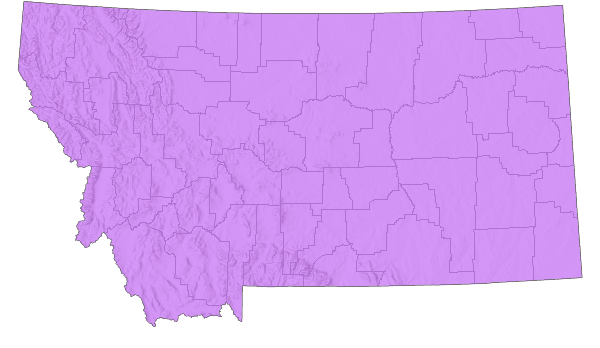
 Native
Native
Range Comments
Creeping Spikerush is circumboreal and occurs south through the United States and Mexico (Lesica et al. 2012).
Observations in Montana Natural Heritage Program Database
Number of Observations: 509
(Click on the following maps and charts to see full sized version)
Map Help and Descriptions
Relative Density
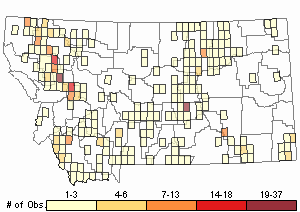
Recency
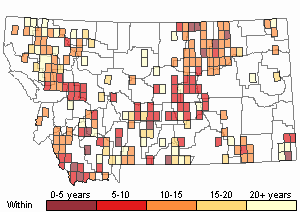

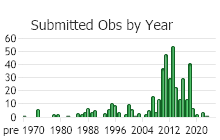
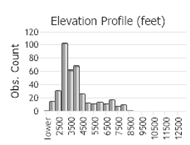 (Observations spanning multiple months or years are excluded from time charts)
(Observations spanning multiple months or years are excluded from time charts)
Habitat
Creeping Spikerush prefers vernally wet to shallow water of wet meadows, margins of lakes, ponds, marshes, and fens from plains and valleys to montane zones (Lesica et al. 2012).
National Vegetation Classification System Groups Associated with this Species
Wetland and Riparian
Peatland
Wet Meadow and Marsh
Ecology
POLLINATION
Creeping Spikerush is a wind-pollinated species (Hauser 2006).
ADAPTATIONS
Creeping Spikerush tolerates pioneer conditions and thrives in disturbed sites (Hauser 2006). It can be found establishing in early-, mid-, and late-successional wetland sites (Hauser 2006). It can quickly populate mud flats after water draws down, yet it can grow in areas flooded up to 1 meter deep and withstand inundation for up to 4 months (USDA 2005). The root masses of Creeping Spikerush extend as deep as 40 cm into the soil profile and can withstand water table levels as low as 30 cm below the surface (USDA 2005).
FIRE
Creeping Spikerush is somewhat adapted to fire disturbance and populations may increase and rebound quite quickly after fire. Dormant seeds and rhizomes are fire tolerant and can re-establish after burning by means of these below-ground features (Hauser 2006). However, all above-ground plant matter is top-killed by fire (Hauser 2006). Studies of sedge meadows in both Oregon and Wisconsin showed that Creeping Spikerush populations increased significantly over the first two years after fire, but then returned to normal population sizes (Hauser 2006; Kost et al. 2000).
WILDLIFE USE
Due to its high vegetative protein content and digestibility, Creeping Spikerush is an important early season food source (USDA 2005). The seeds are heavily grazed late in the season by livestock, large game animals, and ducks (USDA 2005). This species also provides nesting cover for various waterfowl (USDA 2005).
Reproductive Characteristics
Creeping Spikerush has medium seed abundance, moderate seed spread rate, medium seed vigor, and moderate vegetative spread rate (USDA, NRCS 2019).
FLOWERS [Lesica et al. 2012]
Flowers consist of 4 to 6 perianth bristles, 2 stigmas, and 3 stamens. Perianth bristles are longer than the achene. The scales, found at the base of each flower, are 2.5-4 mm long, and brown to purple with a green or tan midrib. The lowest 1 or 2 scales are empty, lacking flowers or achenes.
ACHENES [Lesica et al. 2012]
Achenes are yellow to brown, smooth, obovate, and lenticular. They are 2-3 mm long including the short-stemmed, triangular tubercle that is 0.5 to 1 mm long. The upper portion of the achene is pyramidal in shape and appearing separated from the lower portion which is orbicular to lenticular in shape.
VEGETATIVE [Hauser 2006]
Creeping Spikerush is a clonal species that reproduces asexually by rhizomes. This allows it to form homogenous, monotypic stand anywhere from 1 to 6 feet in diameter. Rhizomes form a near linear growth path with almost no branching. This may aid in efficiently escaping overcrowded areas with already dense vegetation.
LIFE CYCLE [Hauser 2019]
Creeping Spikerush is a perennial species. Fruit does not develop until an individual is 2 to 3 years old. Seeds usually germinate from mid spring through early summer and ripen from July to August. At maturity, the inflorescence quickly disarticulates to spread its seeds by the wind. Seeds that do not germinate are stored in the seed bank. In aquatic habitats, the rhizomes of Creeping Spikerush develop rapidly during mid to late summer.
Management
RESTORATION USES
Creeping Spikerush is a particularly useful species for restoration projects due to its thick, mat-forming rhizomes that aid in controlling erosion and compaction (USDA 2006). Its beneficial effects on soil stability allow sensitive plant species to return and assist in restoring an area to original healthy wetland conditions. When planted in natural areas, this species provides food for wildlife and hosts many beneficial bacteria that help filter waste out of groundwater.
Stewardship Responsibility
Threats or Limiting Factors
Russian Olive Elaeagnus angustifolia) invasions have detrimental effects on Creeping Spikerush populations (Hauser 2006). Wetland sites that are infested with Russian Olive have significantly lower frequency of Creeping Spikerush than uninfested sites (Carman et al. 1982).
References
- Literature Cited AboveLegend:
 View Online Publication
View Online Publication Lesica, P., M.T. Lavin, and P.F. Stickney. 2012. Manual of Montana Vascular Plants. Fort Worth, TX: BRIT Press. viii + 771 p.
Lesica, P., M.T. Lavin, and P.F. Stickney. 2012. Manual of Montana Vascular Plants. Fort Worth, TX: BRIT Press. viii + 771 p.
- Additional ReferencesLegend:
 View Online Publication
View Online Publication
Do you know of a citation we're missing? Boggs, K. W. 1984. Succession in riparian communities of the lower Yellowstone River, Montana. M.S. Thesis. Montana State University, Bozeman, 107 pp.
Boggs, K. W. 1984. Succession in riparian communities of the lower Yellowstone River, Montana. M.S. Thesis. Montana State University, Bozeman, 107 pp. Craig, V.E. 1952. A story of fish production as it applies to Montana. M.Sc. Thesis. Bozeman, MT: Montana State University. 92 p.
Craig, V.E. 1952. A story of fish production as it applies to Montana. M.Sc. Thesis. Bozeman, MT: Montana State University. 92 p. Culver, D.R. 1994. Floristic analysis of the Centennial Region, Montana. M.Sc. Thesis. Montana State University, Bozeman. 199 pp.
Culver, D.R. 1994. Floristic analysis of the Centennial Region, Montana. M.Sc. Thesis. Montana State University, Bozeman. 199 pp. Eggers, M.J.S. 2005. Riparian vegetation of the Montana Yellowstone and cattle grazing impacts thereon. M.Sc. Thesis. Montana State University, Bozeman, MT. 125 p.
Eggers, M.J.S. 2005. Riparian vegetation of the Montana Yellowstone and cattle grazing impacts thereon. M.Sc. Thesis. Montana State University, Bozeman, MT. 125 p. Hildebrand, B. D. 1979. Habitat requirements of molting Canada Geese at Lima Reservoir, Montana. M.Sc. Thesis. Bozeman, MT: Montana State University. 79 p.
Hildebrand, B. D. 1979. Habitat requirements of molting Canada Geese at Lima Reservoir, Montana. M.Sc. Thesis. Bozeman, MT: Montana State University. 79 p. Hollenbeck, R.R. 1974. Growth rates and movements within a population of Rana pretiosa pretiosa Baird and Girard in south central Montana. Ph.D. Dissertation. Bozeman, Montana: Montana State University. 66 p.
Hollenbeck, R.R. 1974. Growth rates and movements within a population of Rana pretiosa pretiosa Baird and Girard in south central Montana. Ph.D. Dissertation. Bozeman, Montana: Montana State University. 66 p. Jones, W. W. 1901. Preliminary flora of Gallatin County. M.S. Thesis. Bozeman, MT: Montana State College. 78 pp.
Jones, W. W. 1901. Preliminary flora of Gallatin County. M.S. Thesis. Bozeman, MT: Montana State College. 78 pp. Lesica, P., M.T. Lavin, and P.F. Stickney. 2022. Manual of Montana Vascular Plants, Second Edition. Fort Worth, TX: BRIT Press. viii + 779 p.
Lesica, P., M.T. Lavin, and P.F. Stickney. 2022. Manual of Montana Vascular Plants, Second Edition. Fort Worth, TX: BRIT Press. viii + 779 p. McCarthy, J.J. 1973. Response of nesting Canada geese (Branta canadensis) to islands in stockdams in northcentral Montana. M.Sc. Thesis. Bozeman, MT: Montana State University. 36 p.
McCarthy, J.J. 1973. Response of nesting Canada geese (Branta canadensis) to islands in stockdams in northcentral Montana. M.Sc. Thesis. Bozeman, MT: Montana State University. 36 p. Mundinger, J.G. 1975. The influence of rest-rotation grazing management on waterfowl production on stock-water reservoirs in Phillips County, Montana. M.Sc. Thesis. Bozeman, MT: Montana State University. 100 p.
Mundinger, J.G. 1975. The influence of rest-rotation grazing management on waterfowl production on stock-water reservoirs in Phillips County, Montana. M.Sc. Thesis. Bozeman, MT: Montana State University. 100 p. Quire, R.L. 2013. The sagebrush steppe of Montana and southeastern Idaho shows evidence of high native plant diversity, stability, and resistance to the detrimental effects of nonnative plant species. M.Sc. Thesis. Bozeman, MT: Montana State University. 124 p.
Quire, R.L. 2013. The sagebrush steppe of Montana and southeastern Idaho shows evidence of high native plant diversity, stability, and resistance to the detrimental effects of nonnative plant species. M.Sc. Thesis. Bozeman, MT: Montana State University. 124 p. Sater, S. 2022. The insects of Sevenmile Creek, a pictorial guide to their diversity and ecology. Undergraduate Thesis. Helena, MT: Carroll College. 242 p.
Sater, S. 2022. The insects of Sevenmile Creek, a pictorial guide to their diversity and ecology. Undergraduate Thesis. Helena, MT: Carroll College. 242 p.
- Web Search Engines for Articles on "Creeping Spikerush"





